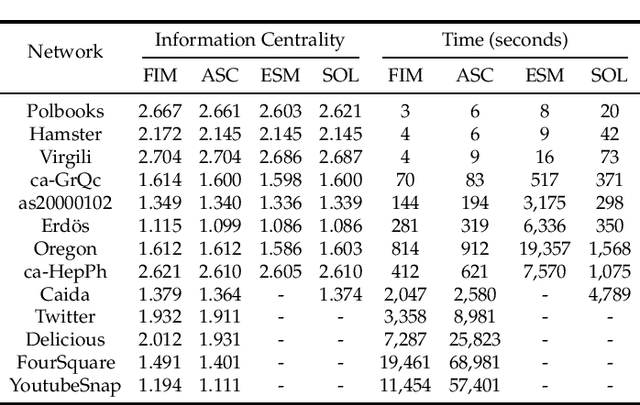Changan Liu
Efficient Algorithms for Computing Random Walk Centrality
Oct 23, 2025Abstract:Random walk centrality is a fundamental metric in graph mining for quantifying node importance and influence, defined as the weighted average of hitting times to a node from all other nodes. Despite its ability to capture rich graph structural information and its wide range of applications, computing this measure for large networks remains impractical due to the computational demands of existing methods. In this paper, we present a novel formulation of random walk centrality, underpinning two scalable algorithms: one leveraging approximate Cholesky factorization and sparse inverse estimation, while the other sampling rooted spanning trees. Both algorithms operate in near-linear time and provide strong approximation guarantees. Extensive experiments on large real-world networks, including one with over 10 million nodes, demonstrate the efficiency and approximation quality of the proposed algorithms.
Finding Influencers in Complex Networks: An Effective Deep Reinforcement Learning Approach
Sep 09, 2023



Abstract:Maximizing influences in complex networks is a practically important but computationally challenging task for social network analysis, due to its NP- hard nature. Most current approximation or heuristic methods either require tremendous human design efforts or achieve unsatisfying balances between effectiveness and efficiency. Recent machine learning attempts only focus on speed but lack performance enhancement. In this paper, different from previous attempts, we propose an effective deep reinforcement learning model that achieves superior performances over traditional best influence maximization algorithms. Specifically, we design an end-to-end learning framework that combines graph neural network as the encoder and reinforcement learning as the decoder, named DREIM. Trough extensive training on small synthetic graphs, DREIM outperforms the state-of-the-art baseline methods on very large synthetic and real-world networks on solution quality, and we also empirically show its linear scalability with regard to the network size, which demonstrates its superiority in solving this problem.
A Fast Algorithm for Moderating Critical Nodes via Edge Removal
Sep 09, 2023



Abstract:Critical nodes in networks are extremely vulnerable to malicious attacks to trigger negative cascading events such as the spread of misinformation and diseases. Therefore, effective moderation of critical nodes is very vital for mitigating the potential damages caused by such malicious diffusions. The current moderation methods are computationally expensive. Furthermore, they disregard the fundamental metric of information centrality, which measures the dissemination power of nodes. We investigate the problem of removing $k$ edges from a network to minimize the information centrality of a target node $\lea$ while preserving the network's connectivity. We prove that this problem is computationally challenging: it is NP-complete and its objective function is not supermodular. However, we propose three approximation greedy algorithms using novel techniques such as random walk-based Schur complement approximation and fast sum estimation. One of our algorithms runs in nearly linear time in the number of edges. To complement our theoretical analysis, we conduct a comprehensive set of experiments on synthetic and real networks with over one million nodes. Across various settings, the experimental results illustrate the effectiveness and efficiency of our proposed algorithms.
 Add to Chrome
Add to Chrome Add to Firefox
Add to Firefox Add to Edge
Add to Edge